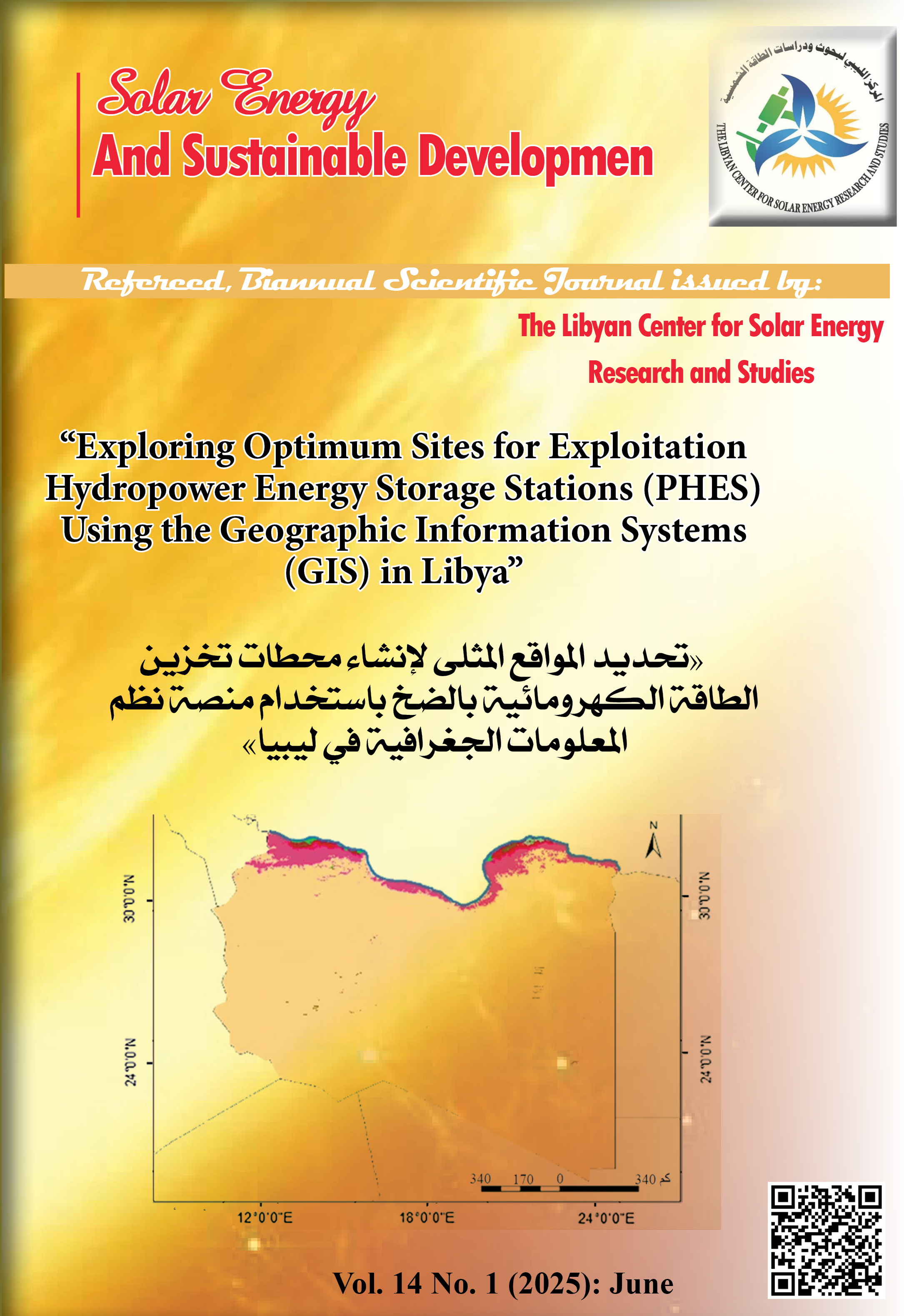Identifying Promising Locations for Establishing Hydropower Energy Storage Stations )PHES( Using the Geographic Information Systems (GIS) in Libya
DOI:
https://doi.org/10.51646/jsesd.v14i1.426الكلمات المفتاحية:
Geographic Information Systems (GIS)، Renewable Energy، Pumped Hydropower Energy Storage (PHES)، Libya.الملخص
يهدف هذا البحث لتحديد المواقع الواعدة لإنشاء محطات تخزين الطاقة الكهرومائية بالضخ (PHES) في ليبيا باستخدام نظم المعلومات الجغرافية (GIS)، وذلك من خلال التركيز على دمج البيانات الجغرافية والمناخية، وتطبيق معايير محددة لتقييم الملائمة المكانية لهذه المحطات. كما هدفت الدراسة إلى استغلال الإمكانات الطبيعية في المنطقة؛ وذلك لتحقيق أهداف استراتيجية الدولة الليبية في التخفيف من العجز في الشبكة بالإضافة لجعل مساهمة الطاقات المتجددة والنظيفة أكبر من 50% في مزيج الطاقة المنتجة بحلول عام 2050. يساهم هذا البحث في التحول نحو الطاقات المتجددة والصديقة للبيئة، مما يتماشى مع الالتزامات الوطنية والدولية، بما في ذلك معاهدة باريس للتغير المناخي، وذلك من خلال تقليل بصمة الكربون وتحقيق الاستدامة في الطاقة. بينت الدراسة وجود العديد من الاماكن الواعدة في ليبيا لإنشاء محطات تخزين الطاقة الكهرومائية، والتي من شأنها أن تقلل العجز في الطاقة الكهربائية إذا ما تم تخزين الفائض منها لاسترجاعها عند الطلب، وكذلك لضمان استقرار الشبكة. وايضا يمكن استخدامها كمصدر لتخزين الطاقة في منظومات الطاقات المتجددة والهجينة. كشفت الدراسة ان حوالي 24.73% من اجمالي مساحة ليبيا يمكن ان تشكل هدفا لإنشاء محطات تخزين الطاقة الكهرومائية بالضخ. ولتحديد الانسب تم تصنيف الاماكن الواعدة الى ثلاثة مستويات استنادا على دمج عدة طبقات والتي يشكل GIS على اساسها مصفوفة اتخاذ القرار. بداية من الأماكن ذات الملائمة العالية والتي شكلت حوالي 4.90%، في حين تمثل الأماكن المتوسطة الملائمة حوالي 6.15%، بينما تشكل الأماكن المنخفضة نحو 13.68% من إجمالي مساحة الاراضي الليبية. وتراوحت الارتفاعات للاماكن الواعدة بين 188- 2200 متر عن سطح الارض، كما تم حساب الطاقة المتاحة لتخزين الطاقة الكهرومائية بالضخ وتراوحت بين 384 – 4,496 وات ساعة لكل متر مكعب من حجم الخزان.
التنزيلات
المقاييس
المراجع
Qery."Renewable Energy Capacity Tracker". https://qery.no/renewable-energy-capacity-tracker/ 2024.
Statista, Global pure pumped storage capacity 2010-2023, 2025. https://www.statista.com/statistics/1304113/pumped-storage-hydropower-capacity-worldwide/
L. Rtemi, W. El-Osta and A. Attaiep,. "Hybrid System Modeling for Renewable Energy Sources". Solar Energy and Sustainable Development Journal, vol. 12, no. 1, pp. 13–28, 2023. https://doi.org/10.51646/jsesd.v12i1.146 DOI: https://doi.org/10.51646/jsesd.v12i1.146
J. Rifa, et al. " A new design for a built-in hybrid energy system, parabolic dish solar concentrator and bioenergy (PDSC/BG): A case study–Libya." Journal of Cleaner Production, vol. 441, no. 2, p. 140944, 2024. https://doi.org/10.1016/j.jclepro.2024.140944 DOI: https://doi.org/10.1016/j.jclepro.2024.140944
F. Alasali, et al. "Assessment of the impact of a 10-MW grid-tied solar system on the Libyan grid in terms of the power protection system stability." Clean Energy, vol. 7, no. 2, pp. 389–407, 2023. https://doi.org/10.1093/ce/zkac084 DOI: https://doi.org/10.1093/ce/zkac084
A. Teyabeen, F. Akkari, A. Jwaid, A. Zaghwan and R. Abodelah, "Assessment of Wind Energy Potential In Zwara, Libya". Solar energy and sustainable development Journal, vol. 8, no. 2, pp. 34–49, 2019. https://doi.org/10.51646/jsesd.v8i2.28 DOI: https://doi.org/10.51646/jsesd.v8i2.28
M. Almaktar and M. Shaaban,. "Prospects of renewable energy as a non-rivalry energy alternative in Libya", Renewable and Sustainable Energy Reviews, vol. 143, p. 110852, 2021. https://doi.org/10.1016/j.rser.2021.110852. DOI: https://doi.org/10.1016/j.rser.2021.110852
A. Alsharif, et al.,. "Mitigation of Dust Impact on Solar Photovoltaics Performance Considering Libyan" Climate Zone: A Review. Wadi Alshatti University Journal of Pure and Applied Sciences, vol. 1, no. 1, pp. 22-27, 2023. https://www.waujpas.com/index.php/journal/article/view/7
Y. Fathi, et al.,. "Optimum Number of Glass Covers of Thermal Flat Plate Solar Collectors" . Wadi Alshatti University Journal of Pure and Applied Sciences, vol. 2, no. 1, pp. 1-10, 2023. https://www.waujpas.com/index.php/journal/article/view/35
M. Abdunnabi, I. Rohuma, E. Endya and E. Belal. "Review on solar water heating in Libya". Solar Energy and Sustainable Development Journal, vol. 7, no. SI, pp. 1–27, 2018. https://doi.org/10.51646/jsesd.v7iSI.72 DOI: https://doi.org/10.51646/jsesd.v7iSI.72
H. Shreif, W. El-Osta and A. Yagub,. "Wind Resource Assessment for southern part of Libya": Case Study of Hun. Solar Energy and Sustainable Development Journal, vol. 8, no. (1), 12–33, 2019. https://doi.org/10.51646/jsesd.v8i1.18 DOI: https://doi.org/10.51646/jsesd.v8i1.18
H. El-Khozondar, et al., "Assessing the Viability of Solar and Wind Energy Technologies in Semi-Arid and Arid Regions". A Case Study of Libya’s Climatic Conditions. Applied Solar Energy, vol 60, no. 1, pp. 149–170, 2024. https://doi.org/10.3103/S0003701X24600218 DOI: https://doi.org/10.3103/S0003701X24600218
S. Mohammed, et al. "Carbon and Energy Life Cycle Analysis of Wind Energy Industry in Libya". Solar Energy and Sustainable Development Journal, vol. 12, no. 1, pp. 50–69, 2023. https://doi.org/10.51646/jsesd.v12i1.150 DOI: https://doi.org/10.51646/jsesd.v12i1.150
A. Jary, M. Elmnifi, Z. Said, L. Habeeb and H. Moria." Potential wind energy in the cities of the Libyan coast, a feasibility study," Journal of Mechanical Engineering Research and Developments, vol. 44, no. 7, pp. 236-252, 2021. https://www.researchgate.net/publication/352994227
M. Khaleel, et al. "Towards Sustainable Renewable Energy". Appl. Sol. Energy, vol. 59, pp. 557–567, 2023. https://doi.org/10.3103/S0003701X23600704 DOI: https://doi.org/10.3103/S0003701X23600704
O. Mohamed and S. Masood,. "A brief overview of solar and wind energy in Libya". Current trends and the future development, IOP Conference Series: Materials Science and Engineering".2018, 377 012136 https://doi.org/10.1088/1757-899X/377/1/012136. DOI: https://doi.org/10.1088/1757-899X/377/1/012136
K. Amer, et al. "Economic-Environmental-Energetic (3E) analysis of Photovoltaic Solar Energy Systems: Case Study of Mechanical & Renewable Energy Engineering Departments at Wadi AlShatti University". Wadi Alshatti University Journal of Pure and Applied Sciences, 3(1), 51-58, 2025. https://doi.org/10.63318/waujpasv3i1_09. DOI: https://doi.org/10.63318/waujpasv3i1_09
N. Abouhmod, et al. "Regression model for optimum solar collectors’ tilt angles in Libya." In the 8th International Engineering Conference on Renewable Energy & Sustainability, 08-09 May 2023, Gaza, Palestine. https://doi.org/10.1109/ieCRES57315.2023.10209547 DOI: https://doi.org/10.1109/ieCRES57315.2023.10209547
M. Abdunnabi, N. Etiab, Y. Fathi, H. El-Khozondar and R. Khargotra. " Energy savings strategy for the residential sector in Libya and its impacts on the global environment and the nation economy." Advances in Building Energy Research, vol. 17, no. 4, pp. 379–411, 2023. https://doi.org/10.1080/17512549.2023.2209094 DOI: https://doi.org/10.1080/17512549.2023.2209094
M. Eteriki, W. El-Osta, Y. Fathi and H. El-Khozondar. "Effect of Implementation of Energy Efficiency in Residential Sector in Libya." In the 8th International Engineering Conference on Renewable Energy & Sustainability, 08-09 May 2023, Gaza, Palestine. https://doi.org/10.1109/ieCRES57315.2023.10209521 DOI: https://doi.org/10.1109/ieCRES57315.2023.10209521
Y. Nassar, H. El-Khozondar and M. Fakher, "The role of hybrid renewable energy systems in covering power shortages in public electricity grid: An economic, environmental and technical optimization analysis." Journal of Energy Storage, vol. 108, no. 2, p. 115224, 2025. https://doi.org/10.1016/j.est.2024.115224. DOI: https://doi.org/10.1016/j.est.2024.115224
Y. Nassar, et al., "Design of reliable standalone utility-scale pumped hydroelectric storage powered by PV/Wind hybrid renewable system", Energy Conversion and Management,.(2024) 322(12) 119173. https://doi.org/10.1016/j.enconman.2024.119173. DOI: https://doi.org/10.1016/j.enconman.2024.119173
Y. Nassar, M. Abdunnabi, M. Sbeta and A. Hafez. "Dynamic analysis and sizing optimization of a pumped hydroelectric storage-integrated hybrid PV/Wind system": A case study. Energy Conversion and Management, 229(2) 113744. https://doi.org/10.1016/j.enconman.(2020).113744. DOI: https://doi.org/10.1016/j.enconman.2020.113744
E. Salim, A. Abubaker, B. Ahmed and Y. Nassar. "A Brief Overview of Hybrid Renewable Energy Systems and Analysis of Integration of Isolated Hybrid PV Solar System with Pumped Hydropower Storage for Brack city" - Libya. Wadi Alshatti University Journal of Pure and Applied Sciences, 3(1), 152-167, 2025. https://doi.org/10.63318/waujpasv3i1_22. DOI: https://doi.org/10.63318/waujpasv3i1_22
A. Ali, E. Karram, Y. Nassar and A. Hafez. "Reliable and economic isolated renewable hybrid power system with pumped hydropower storage." The 22nd international Middle East power systems conference, 14-16 December 2021, Assiut, Egypt, pp. 515-520 . https://do.org/10.1109/MEPCON50283.2021.9686233 DOI: https://doi.org/10.1109/MEPCON50283.2021.9686233
Y. Nassar, M. Salem and H. El-Khozondar. "Estimation of CO2 Emissions from the Electric Power Industry Sector in Libya". Solar Energy and Sustainable Development Journal, vol. 14, no. 1, 2025. pp. 42–55. https://doi.org/10.51646/jsesd.v14i1.415 DOI: https://doi.org/10.51646/jsesd.v14i1.415
M. Abuqila, Y. Nassar, and M. Nyasapoh. "Estimation of the Storage Capacity of Electric Vehicle Batteries under Real Weather and Drive-mode Conditions: A Case Study". Wadi Alshatti University Journal of Pure and Applied Sciences, 3(1), 58-71, 2025. https://doi.org/10.63318/waujpasv3i1_10 DOI: https://doi.org/10.63318/waujpasv3i1_10
M. Khaleel, et al. "Evolution of Emissions: The Role of Clean Energy in Sustainable Development." Challenges in Sustainability, vol. 12, no. 2, pp.122-135, 2024. https://doi.org/10.56578/cis120203 DOI: https://doi.org/10.56578/cis120203
E. Najem and F. Alhadar. "Utilizing Geographic Information Systems to Identify Optimal Locations for Establishing Solar Power Plants in the Sebha Region." Solar Energy and Sustainable Development Journal, vol. 14, no. FICTS-2024, pp. 36–54, 2025. https://doi.org/10.51646/jsesd.v14iFICTS-2024.442 DOI: https://doi.org/10.51646/jsesd.v14iFICTS-2024.442
I. Badi, D. Pamucar, L. Gigović and S. Tatomirović,. "Optimal site selection for sitting a solar park using a novel GIS- SWA’TEL model": A case study in Libya. International Journal of Green Energy,2021. 18(4), 336–350. https://doi.org/10.1080/15435075.2020.1854264 DOI: https://doi.org/10.1080/15435075.2020.1854264
T. El hasady and M. Hasni. "GIS-Based Decision Support System for Wind Farm Site Selection." Alqrtas Journal, vol. 14. 2021. https://alqurtas.alandalus-libya.org.ly/ojs/index.php/qjhar/article/view/385/322
H. Zurqani. Environmental Applications of Remote Sensing and GIS in Libya. Springer, Cham. https://doi.org/10.1007/978-3-030-97810-5_12 DOI: https://doi.org/10.1007/978-3-030-97810-5_12
H. Algassie, M. Fakroun, M. Miskeen and I. Gargar. "The Use of GIS and Multi-Criteria Fuzzy Logic to Assess and Identify Flood-Prone Areas in the Greater Ghat Region". Wadi Alshatti University Journal of Pure and Applied Sciences, vol. 1, no. 1, pp. 37-47, 2023. https://www.waujpas.com/index.php/journal/article/view/15
K. Abdunaser. "Oil Pollution Monitoring and Detection Using GIS and Remote Sensing Techniques": A Case Study from Libya. In: Springer, Cham.2022. https://doi.org/10.1007/978-3-030-97810-5_11 DOI: https://doi.org/10.1007/978-3-030-97810-5_11
S. Mohammed, Y. Fathi, H. Algassie, A. Mahammed, H. El-Khozondar and A. Alatrash. "Exploring Promised Sites for Establishing Hydropower Energy Storage (PHES) Stations in Libya by Using the Geographic Information Systems (GIS)." Wadi Alshatti University Journal of Pure and Applied Sciences, vol. 3, no. 1, pp. 85-94, 2025. https://doi.org/10.63318/waujpasv3i1_13 DOI: https://doi.org/10.63318/waujpasv3i1_13
J. Ruiz, J. Haya, R. García, P. Alonso and R. Álvarez. "Optimal location of hydraulic energy storage using geographic information systems and multi-criteria analysis". Journal of Energy Storage, vol. 49, no. 5, p. 104159, 2022. https://doi.org/10.1016/j.est.2022.104159. DOI: https://doi.org/10.1016/j.est.2022.104159
H. Ahmed, M. Mohamed and S. Saleh. "A GIS model for exploring the water pumped storage locations using remote sensing data". The Egyptian Journal of Remote Sensing and Space Science, vol. 24, no. 3, pp. 515-523, 2021. https://doi.org/10.1016/j.ejrs.2021.09.006. DOI: https://doi.org/10.1016/j.ejrs.2021.09.006
J. Li, D. Chen, W. Han, P. Wang, Z. Zhao & G. Liu,. "Site identification and capacity determination of pumped hydro storage plants using GIS and spatial MCDM in Northwest China". Energy Conversion and Management, vol. 322, no. 12, p. 119179,2024. https://doi.org/10.1016/j.enconman.2024.119179. DOI: https://doi.org/10.1016/j.enconman.2024.119179
S. Ali, R. Stewart, O. Sahin and A. Vieira,. "Integrated GIS-AHP-based approach for off-river pumped hydro energy storage site selection". Applied Energy, vol. 337, no. 5, p. 120914, 2023. https://doi.org/10.1016/j.apenergy.2023.120914 DOI: https://doi.org/10.1016/j.apenergy.2023.120914
N. Ghorbani, H. Makian and C. Breyer,. "A GIS-based method to identify potential sites for pumped hydro energy storage - Case of Iran". Energy, vol. 169, no. 12, pp. 854-867, 2019. https://doi.org/10.1016/j.energy.2018.12.073 DOI: https://doi.org/10.1016/j.energy.2018.12.073
T. Soha, et al. GIS-based assessment of the opportunities for small-scale pumped hydro energy storage in middle-mountain areas focusing on artificial landscape features, Energy, vol. 141, no. 12, p. 1363-1373, 2017. https://doi.org/10.1016/j.energy.2017.11.051 DOI: https://doi.org/10.1016/j.energy.2017.11.051
B.Lu, M. Stocks, A. Blakers, K. Anderson,. "Geographic information system algorithms to locate prospective sites for pumped hydro energy storage",.2018. Applied Energy. DOI: https://doi.org/10.1016/j.apenergy.2018.03.177
https://www.embassyoflibya.ca/pages/about-libya-ar
General Water Authority, Water report.2020. https://water.fanack.com/ar/libya/water-resources-in-libya/
A. Miskeen, et al., "Electricity from wastewater treatment plants". Solar Energy and Sustainable Development Journal,.2023. 12(2), 24–37. https://doi.org/10.51646/jsesd.v12i2.156. DOI: https://doi.org/10.51646/jsesd.v12i2.156
Y. Nassar, et al. "Towards Green Economy: Case of Electricity Generation Sector in Libya", Solar Energy and Sustainable Development Journal,.2025 vol. 14, no.1, pp. 334-360, 2025. https://doi.org/10.51646/jsesd.v14i1.549 DOI: https://doi.org/10.51646/jsesd.v14i1.549
General Electricity Company of Libya,.2012 Statistics http://www.gecol.ly/resources/documents/reports/static_ar_2012.pdf
M. Salem, A. Elmabruk, M. Irhouma, and I. Mangir. "Assessment of Wind Energy Potential in Western Mountain: Nalut and Yefren as Case Study". Wadi Alshatti University Journal of Pure and Applied Sciences, 3(1), 35-42, 2025. https://doi.org/10.63318/waujpasv3i1_7. DOI: https://doi.org/10.63318/waujpasv3i1_7
H. El-Khozondar, et al. "Economic and Environmental Implications of Solar Energy Street Lighting in Urban Regions: A Case Study". Wadi Alshatti University Journal of Pure and Applied Sciences, 3(1), 142-151, 2025. https://doi.org/10.63318/waujpasv3i1_21 DOI: https://doi.org/10.63318/waujpasv3i1_21
A. Aqila, and S. Suliman. "Design of Hybrid Renewable Energy System (PV/Wind/Battery) Under Real Climatic and Operational Conditions to Meet Full Load of the Residential Sector: A Case Study of a House in Samno Village– Southern Region of Libya". Wadi Alshatti University Journal of Pure and Applied Sciences,2025. 3(1), 168-181. https://doi.org/10.63318/waujpasv3i1_23. DOI: https://doi.org/10.63318/waujpasv3i1_23
M. Khaleel, T. Ghandoori, A. Ahmed, A. Alsharif, A. Alnagrat and A. Abulifa, "Impact of Mechanical Storage System Technologies: A Powerful Combination to Empowered the Electrical Grids Application," 2022 IEEE 2nd International Maghreb Meeting of the Conference on Sciences and Techniques of Automatic Control and Computer Engineering (MI-STA), Sabratha, Libya, 2022, pp. 628-636, https://doi.org/10.1109/MI-STA54861.2022.9837670. DOI: https://doi.org/10.1109/MI-STA54861.2022.9837670
M. Khaleel, et al. "Analyzing China's Solar PV Sector: Lessons for Global Application." Solar energy and Sustainable Development Journal. Under consideration.

التنزيلات
منشور
كيفية الاقتباس
إصدار
القسم
الرخصة
الحقوق الفكرية (c) 2025 Solar Energy and Sustainable Development Journal

هذا العمل مرخص بموجب Creative Commons Attribution-NonCommercial 4.0 International License.













